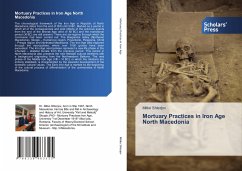The chronological framework of the Iron Age in Republic of North Macedonia dates from the end of XI/X until VI BC. Marked as a period in which all of the consequences and post effects of the previous events from the end of the Bronze Age (end of XII BC) and the transitional period (XI BC) are still present. There are six regions through which the conclusion had been carried out: The Bregalnica Valley (Northeast Macedonia), Skopje - Kumanovo region, Povardarie, Pelagonia, Ohrid - Prespa region and Northwest Macedonia. The Iron Age best explored through the necropolises, where over 1000 graves have been excavated. The Iron Age necropolises represent a new life phase in the inhumed - skeletal burials from the previous period. This period in North Macedonia also presents the new Hallstatt cultural elements with a background originating from the Northwestern Balkans. The next phase of the Middle Iron Age (VIII - VI BC), in which the relations are entirely stabilized, is characterized by the peaceful development of the domestic cultural values. The Early Iron Age is marked by the beginning of the cultural process of differentiation of the communities in North Macedonia.
Bitte wählen Sie Ihr Anliegen aus.
Rechnungen
Retourenschein anfordern
Bestellstatus
Storno








